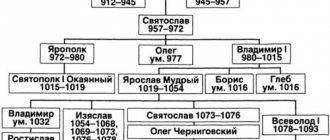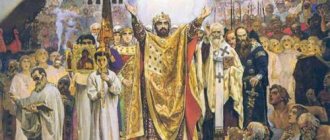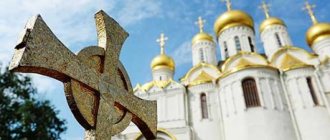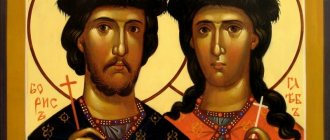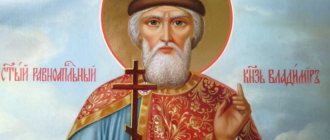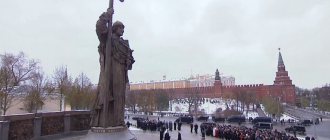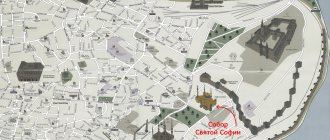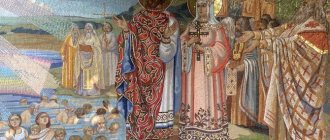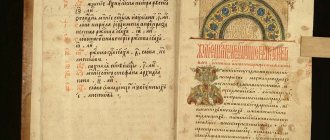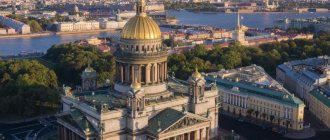Ancient chronicles tell that in 990, the Grand Duke of Kiev Vladimir, the baptist of the Russian land, founded a city on the Klyazma River, which he named after himself. At the beginning of the 12th century, his brainchild was destined to become the center of the Vladimir-Suzdal principality, which for a century and a half united Russian lands around itself. The list of Vladimir princes is given in the article, but before we briefly talk about those of them who left the most striking mark in the history of Ancient Rus', we will devote a few lines to the founder of the city of Vladimir himself. Both historical documents and legends that have become examples of folk epics tell about him.
Prince Vladimir Cathedral - a monument to the Baptist of Rus'
The role played by Prince Vladimir of Kiev in the formation of the Old Russian state is so great that he can rightfully be considered one of the most outstanding figures in Russian history. Leaving the darkness of paganism in the past, he introduced Rus' into the families of Christian peoples. His contribution to the formation of its administrative-territorial system is also important. The memory of the prince is immortalized in the works of many domestic sculptors and architects.
His figure is one of the central ones in the famous monumental composition erected in 1862 in Veliky Novgorod on the occasion of the celebration of the Millennium of Russia. An equally famous monument is the Prince Vladimir Cathedral in St. Petersburg, built by order of Catherine II in 1789. And today the image of the prince serves as a source of inspiration for many artists.
Thus, in November 2021, his monument by Salavat Shcherbakov was unveiled in Moscow. In its compositional design, it echoes the recognized masterpiece of the past - the monument that decorated Vladimir Hill in Kyiv in 1852. Many other works of art were created dedicated to him. Among the temple buildings, the most famous is the above-mentioned Prince Vladimir Cathedral in St. Petersburg.
Fictional genealogy
As for the subsequent successors of the Kyiv prince, who settled on the banks of the Klyazma, information about them at one time was widely disseminated from a literary monument of the 16th century, known as “The Tale of the Princes of Vladimir”. It cited a legend according to which the great princes were distant descendants of the Roman emperor Augustus. This version was used by its creators solely for political purposes, and has no real justification. Therefore, it should be considered only as a literary curiosity.
Successors of the Kyiv prince
However, let us turn to the Vladimir princes - the rulers of the state, the center of which was the city founded in 990 on the Klyazma River. By the middle of the 12th century, it transformed from a small settlement into a powerful capital of the newly formed principality. The city owes its prosperity to the first Vladimir prince, Andrei Bogolyubsky (1111-1174), who moved his palace to the banks of the Klyazma and gave it the status of an administrative center.
No less significant in the history of the Vladimir Principality was the period of reign of his successor, Vsevolod Yuryevich, nicknamed the Big Nest. Thanks to his activities aimed at uniting small appanage principalities into a single state, which under his leadership reached unprecedented prosperity, he went down in history as one of the most powerful rulers. It is characteristic that it was under him that the title of “great” was established for the Vladimir princes.
Period of fragmentation
From this moment until the 14th century, Rus' represented many fragmented principalities: from fifteen at the beginning to more than two hundred at some points. The princes of Kievan Rus during this period lost their influence, although for some time the descendants of Rurik still fought for the Kievan throne, which until then was considered the most important.
Among the many people who occupied it at that time, it is worth noting Prince Yuri, the sixth son of Vladimir Monomakh. He inherited the Rostov-Suzdal principality, which had fertile soils, was well protected by forests, and had important trade routes through its territories, but he still constantly tried to “lay hands” on Kyiv, for which he received the popular nickname Dolgoruky. And yes, it was he who founded Moscow.
But already his son, Andrei, understood that Kiev had by that time lost its economic importance, therefore, when his father finally took the throne in it, he took and fled from him to his Rostov-Suzdal principality, taking with him the icon of Our Lady of Vladimir .
Here he moved the capital of the principality to the small town of Vladimir-on-Klyazma and began to intensively build it up, develop and improve his principality. As a result, by the time of his death, the Rostov-Suzdal principality, now called Vladimir-Suzdal, becomes a new great one instead of the old Kyiv one.
The prince was killed as a result of a conspiracy by local boyars, with whom he had fought all his life to strengthen power. After his death, Andrei’s brother, Vsevolod the Big Nest, began to rule (he received his nickname due to the large number of sons). He brutally killed the boyars who were responsible for the death of his brother, and completely subjugated the boyars in the principality to himself. During his lifetime, the development of the principality continued and the conquest of Veliky Novgorod began, which was completed by his son. Now there was no doubt that the great princes of Rus' are those who rule in Vladimir.
Defender of the Russian Land - Prince Alexander Nevsky
Among the rulers of the Vladimir Principality there were such outstanding personalities that their activities left an imprint not only on the development of the Old Russian state, but also on the course of all European history. One of them can rightfully be called the son of the Grand Duke of Vladimir Yaroslav Vsevolodovich Alexander, who received the title of “Nevsky” for his victory over the Swedes.
He entered the history of Ancient Rus' primarily as an outstanding commander who managed to defeat the Swedish invaders, giving them a battle in the summer of 1240 at the mouth of the Neva, and who defeated the previously invincible Teutonic knights on the ice of Lake Peipsi in 1242. With these victories, he moderated the aggressive aspirations of his opponents, and, according to historians, saved a number of European nations from their invasion.
Vladimir the Great
After Svyatoslav there were three sons left: Yaropolk, Oleg and the youngest - Vladimir, who was born from a female servant. The image of Vladimir as the Grand Duke of Ancient Rus', who brought Orthodoxy to Rus', has reached us through popular culture as an incredibly kind, noble, intelligent, honest man.
But, frankly speaking, these were cruel times, and Vladimir was a man of his time. To begin with, it is worth saying that initially power over Kiev passed to Svyatoslav’s eldest son, Yaropolk, and Vladimir received wayward Novgorod. Oleg inherited the lands of the Drevlyans, but a few years later a bloody feud broke out between the brothers: Yaropolk killed Oleg, Vladimir fled overseas, brought a squad of Varangians with him, killed his elder brother and began to rule alone.
Vladimir achieved significant success in centralizing Rus': during his reign, several more Slavic peoples joined the country, but most importantly, the prince created the first defense against the hated Pechenegs - a series of fortresses along the river lines that separated Rus' from the steppes of the nomads. This protected the country from raids for a long time, and these fortresses themselves became overgrown with folk legends and served as prototypes for “heroic outposts.”
But, of course, the Baptism of Rus' in 988 brought Vladimir the greatest fame. The baptism of the prince himself took place on the territory of Byzantium, in the city of Korsun, in exchange for this Vladimir received the Byzantine princess Anna, the emperor’s sister, as his wife. Although various higher meanings are attributed to this event, the Baptism of Rus', first of all, was an important political decision.
Prince Vladimir had long sought to bring religion to Rus' in order to unite with one faith many different peoples within the country, each of whom worshiped their own pagan gods. In addition, the adoption of Christianity also made Rus' a civilized and equal country in the eyes of Byzantium, and after it the rest of the international community, significant cultural and trade mutual influence with other countries began.
Warrior-diplomat
A characteristic feature of the son of the Grand Duke of Vladimir, Yaroslav Vsevolodovich, was the combination of unbridled courage with the ability, when required, to build subtle political calculations. This was especially evident in his diplomatic activities. Realizing that having won military victories over its Western opponents, Rus' could not resist the Tatars, Alexander Nevsky made every effort to prevent their raids. During his trip to the Golden Horde, he managed not only to establish relations with Khan Batu, but even to become related to one of his sons. This was a very subtle diplomatic move, thanks to which a significant part of Rus' received a respite from incessant robberies, and he himself was awarded the khan's label for the reign of Kiev.
Researchers note that Alexander Nevsky inherited the ability to negotiate with proud and arrogant Tatar khans from his father, Prince of Vladimir Yaroslav Vsevolodovich. In 1238, after the defeat caused by the Tatars in Vladimir, he was summoned by Batu to his headquarters, located in the lower reaches of the Volga. Having proven himself to be a subtle psychologist and a skilled diplomat, Prince Yaroslav managed to win the sympathy of the khan and receive from him the right to reign throughout Rus'.
Yaroslav the Wise
Vladimir was a serious man: he left as many as twelve heirs from several wives. It is not surprising that civil war broke out between them after his death.
The eldest son Svyatopolk, without any particular reason, killed two brothers, Boris and Gleb, who were his father’s favorites, for which he received the nickname Damned. The brothers were canonized by the church as saints. As a result, Svyatopolk himself was expelled from the country by Yaroslav with the help of Novgorod and the Varangians in 1019, just as his father Vladimir did with his older brother.
The name of Yaroslav the Wise is associated with the period of the highest power of Kievan Rus: the country gained great international influence, all Russian princes became related to many important European royal courts, for example, Yaroslav himself was married to a Swedish princess, his son Vsevolod - to the daughter of the Byzantine emperor, and his granddaughter became related with the German Emperor. And so with all members of a huge family. What prince before him could boast of such influence?
Under the reign of Yaroslav, the culture of Rus' greatly advanced: architecture, painting, and trade developed. Yaroslav annexed the Baltic territories to Rus', the southern borders were safe from the Pechenegs, and Kyiv itself as a city was no longer inferior to the capital of Byzantium. It is to Yaroslav that history ascribes the creation of the first set of laws in the country: “Russian Truth,” although many of his descendants later supplemented it.
Having suffered the hardships of the internecine war, Yaroslav realized that something had to be done about it, and therefore was the first to establish a certain order of succession to the throne in the country. Now power was transferred through the male line from the eldest son to the youngest, and after them to the eldest grandson, thus, in order, the eldest man in the Rurik family always became the Kiev prince.
Nephew of Alexander Nevsky
An attempt to resist the hordes of Khan Batu by force was made in 1252 by the second son of Yaroslav Vsevolodovich (nephew of Prince Alexander Nevsky), also the future ruler of the Vladimir principality - Yaroslav Yaroslavovich. With the support of his brother Andrei and contrary to the prohibitions of the then ruling Alexander Nevsky, he tried to give battle to the Tatars in the Pereslavl region, but was defeated and barely escaped. However, he later managed to establish relations with the khan and, after the death of his brother, take his place in the reign of Vladimir.
Vladimir Monomakh
Although Yaroslav left clear instructions for succession to the throne to his sons, this did not keep the country from new civil strife. For some time, the throne passed from hand to hand between the sons and grandsons of Yaroslav, until it finally settled on Vladimir Vsevolodovich Monomakh.
As mentioned above, Yaroslav’s son, Vsevolod, was married to the daughter of the Byzantine Emperor Constantine Monomakh, and Vladimir, it turns out, was his grandson too. This is where the nickname Monomakh came from, as well as the famous hat, which after him became an indispensable attribute of Russian rulers. An interesting fact is that, unlike the previous princes of Kievan Rus, Vladimir did not take the throne by force. The residents of Kyiv themselves called him to rule after Svyatopolk Izyaslavovich, who was sitting there, died in 1113. In fact, the reign of Vladimir Monomakh is the last period of the integrity of Kievan Rus and the last years of its golden age.
After the death of Vladimir, his son Mstislav ascended the throne in 1125, and for another seven years he more or less managed to maintain the unity of the country, but immediately after his death, Kievan Rus disintegrated into many separate principalities.
Prince Dmitry Alexandrovich
History has also preserved the names of those Vladimir princes who, having spent many years in internecine wars and finally being awarded the title of grand duke, did not glorify their names with any noticeable deeds. In this regard, it is appropriate to recall the second son of Alexander Nevsky, Dmitry, whom his father appointed to rule Veliky Novgorod during his lifetime. However, he was unable to gain authority among his subjects, and after the death of Alexander, he was expelled with dishonor.
He was very loyal to his uncle Yaroslav Yaroslavovich, who took the Vladimir throne after Alexander Nevsky, but when he died, he made every effort to take his place. A long and bloody internecine war began, in which the blood of both Dmitry Yaroslavovich himself and two other contenders - his uncle Vasily and younger brother Andrei - was shed.
Each of them, in order to defeat their relatives, resorted to the most unseemly tricks. False denunciations were used to the ruling Khan of the Horde, Tuda-Meng, as well as betrayal and false oaths. As a result, Dmitry Alexandrovich nevertheless achieved what he wanted and began to be called the Grand Duke of Vladimir, but in 1293 he was removed from the throne by his brother Andrei and ingloriously fled to Pskov. On the way, he fell into the hands of robbers and died from his wounds.
Home » » » The first trip of Alexander Yaroslavich to the Horde to Batu Khan and to Great Mongolia (1247-1249) “Nevryuev’s army” (July 1252) Alexander Nevsky - Grand Duke of Vladimir (1252-1263). In the Horde, Alexander was recognized as the Grand Duke of Vladimir. Alexander Yaroslavich solemnly arrived in Vladimir, returning from his third trip to the Horde. He was met in Vladimir by Metropolitan Kirill III, abbots, priests, boyars and all the people at the Golden Gate under the command of the thousand-man Roman Mikhailovich.
Orekhov Andrey Valerievich. Entry of Alexander Nevsky into Vladimir for the Great Reign
Metropolitan Kirill in the Vladimir Assumption Cathedral elevated the prince to the Great Reign of Vladimir. Like Prince Alexander Nevsky, Kirill chose in his politics the path of recognizing the dominance of the Mongols and opposing Western Catholic expansion. Peace reigned in the Vladimir land. There was general joy. The Grand Duke immediately began to care about the people's welfare. People, frightened by Nevruy's invasion, returned to their homes, farmers - to the plow, priests - to temples. “After Nevryuev’s captivity, Grand Duke Alexander erected churches, filled the city with people, and gathered the people who had fled into their homes.” The establishment of calm in Vladimir influenced the Ryazan principality. The Tatars released from captivity the Ryazan prince Oleg Ingvarich, who suffered for a long time in captivity; after 6 years he became a monk at home and died as a schema-monk. His son Roman took over the reign of Ryazan. From that time on, Alexander’s life was connected with Vladimir. From here he ruled Russia, and his permanent residence was Vladimir and the Vladimir land. Vladimir, one of the oldest cities in North-Eastern Rus', has long been loved by the Suzdal princes, who always preferred it to the two older cities: Suzdal and Rostov. Alexander loved Novgorod, but apparently he was drawn to Vladimir by long-standing childhood memories. By nature, he was a Suzdal prince, a continuer of the family traditions of the clan. Vladimir was connected with many generations of his ancestors. There was neither a veche nor a strong independent boyars here. The prince was the owner of the land, which had long since been a strongly established principality. He was its builder and creator. The very structure of Vladimir life was calmer, more measured and stricter than in Novgorod. Alexander had a special affinity for Suzdal life. And his image in that depth and silence that is inherent in him, despite the whirlwind of external life, is presented not against the backdrop of Novgorod, not the Massacre of Peipus, not the Khan’s headquarters, but against the backdrop of quiet Vladimir. In Alexander himself there is a deep consonance with Vladimir, not only with his way of life, but with his entire appearance, his temples and the surrounding nature. Vladimir lay on a narrow and high steep strip, between the Klyazma and Lybid rivers. Like all the cities of Suzdal Rus', it consisted of Detinets - an internal city and a stockade - an external city. The spit on which Vladimir is located was so narrow that the fort did not surround the fort, which stood directly above the cliff, but closed it on both sides, and was itself divided into two cities: Pecherny and Novy. Many gates led from the fort to Detinets: Volzhsky, Copper, Arinin, Silver and the main Golden, with the Temple of the Rises of the Position above the passage gate. The favorite city of the Suzdal princes and temple builders, all of Vladimir was white with temples. Above the steep bank of the Klyazma stood the cathedral church of the Assumption of the Virgin Mary, with the main shrine of Vladimir - the miraculous icon of the Vladimir Mother of God. The princely courtyard was connected by covered passages to the choir of the Church of St. Demetrius of Thessalonica. On the same cliff above Klyazma, in Detinets itself, there was a men’s monastery, and behind the walls, in a prison, above Lybid, there was the Assumption Princess Monastery for women, in which Princess Maria, the grandmother of St. Alexander Nevsky, took monastic vows. In Novgorod, churches scattered throughout the city were erected by boyars and eminent merchants and spoke of the independence of each end. Here, whitewashed among the wooden huts, trading houses and churches, stone temples were erected by the Suzdal princes. St. George's was built by Yuri Dolgoruky, Spaso-Preobrazhensky by Andrei Bogolyubsky, Exaltation on Torgovishche by Konstantin Vsevolodovich. All these temples - slender, purely Suzdal, white stone, with armored carved decorations, with narrow high windows, with many domes on narrow and high drums - rose on a steep cliff above the wide flood of two rivers and the expanses of flooded meadows. Near these temples, among the wooden buildings, winded narrow and almost impassable streets in the mud, filled on trade days and patronal holidays with homespun Russia coming from the surrounding villages, in which the northern Great Russian type was already taking shape: gray eyes, light “flaxen” hair and beards , northern regional dialect. Against the background of this picture - wide open spaces, free floods of rivers and far-ranging roads - the image of St. Alexander in the last decade of his life arises. During these years, in the intervals between trips to the Horde and campaigns, his life was no different from the life of his fathers and grandfathers. At dawn he walked along the covered passage from the prince's tower to the Church of St. Demetrius of Thessalonica for early mass. Conducted princely justice over the tax-payers. Conversed with Metropolitan Kirill. He talked with wanderers and monks, “loving the church rite.” I went out on autumn mornings during the first frosts to fish in the Bogolyubov groves. The Vladimir period of life revealed in Alexander new features of a prince - a peaceful builder and ruler of the land. These traits could not appear during the reign of Novgorod. There he was only a warrior prince defending the Russian borders. His attempts to get closer to managing the land caused strife with the Novgorodians. Only here, in Suzdal Rus', he was fully the prince whose activity in the minds of both the princes and the people is inseparable from the very concept of princely service. Many years later, people in Vladimir remembered the care Alexander Yaroslavich showed towards Vladimir churches. The Vladimir bishop Jacob (in the schema John) at the end of the 13th century wrote in his letter to one of the sons of Alexander Nevsky (Dmitry or Andrey) and set their father as an example: “See, son prince, what were the great princes, your great-grandfathers and grandfathers and your father, Grand Duke Alexander, decorated the Church of God with choir shrines and books, and rich houses, and great tithes throughout the city, and church courts.”
War with the Lithuanians and Livonian Germans
After Alexander Yaroslavich’s harsh response to the pope’s ambassadors in Rome, they should have lost all hope for the voluntary submission of the Russians. But this did not mean that the popes would leave Russia alone. Given the persistence and strict consistency of Roman policy in achieving the intended goals, known to the whole world, it was to be expected that the popes, having failed in their attempt to seduce the Russians through persuasion and flattery, would return again to the usual method of conversion at that time - through weapons. Indeed, soon after the famous embassy, the papacy’s hostile actions directed against our Fatherland resumed. Contemptuously mixing Russians with Tatars, Pope Innocent IV in 1253 sent the bishops and clergy of Livonia, Estonia and Prussia an order to preach a crusade against the Tatars, who were devastating Livonia and Estonia. Alexander Nevsky foresaw that the failure of papal machinations and intrigues in the Horde would once again raise the question of armed struggle. And he was not mistaken - events developed precisely in this direction. In 1255-1256 the new Pope Alexander IV tried to return to military action against Northern Rus'. He was in a hurry to resume the fight against the Orthodox Russian people, so to speak, along the entire line, raising the Lithuanians, Livonians and Swedes against us. Under his influence, the Swedes and the Livonian Order were the first to go on the offensive again. The Swedes began to seize the lands of the Karelians and baptize the population. Following them, the Danes invaded the possessions of Novgorod. The pope’s views are well outlined in his suggestions addressed to the knights: “All lands, fortifications, towns and cities - we accept all this into the full ownership of St. Peter. After conversion to Christianity (that is, to Catholicism), all these lands, by virtue of our definition, should be subject to the throne for eternity. The greatest attention should be paid to the Russians, who adhere to the Greek schism." The popes began to attract special attention to the Lithuanian people, among whom a significant change took place in the second half of the 13th century. For a long time, Lithuanians obeyed many princes. Their raids on neighboring lands were devastating, but in the absence of unity of power they did not have a lasting aggressive character. In the second half of the 13th century, under the pressure of external circumstances, a desire to establish autocracy was revealed among the Lithuanian people. Prince Mindovg decisively moved towards this goal, without considering the means. A man of iron will, unusually cunning and cruel, who did not stop at any atrocity, he was a striking type of the founder of a state in barbarian times. What he did not achieve by force, he achieved through cunning, deceit and bribery. Our chronicler says about him: “He began to beat his brothers and his sons, and drove others out of the land, and began to rule alone in the whole land of Lithuania.” In addition to the Russians, the Lithuanians were at enmity with the Germans, who had already managed to conquer their fellow Prussians. Realizing the impossibility of fighting both Russians and Germans at the same time, Mindovg, in order to protect himself from German attacks and ensure the success of offensive actions against the Russians, announced to the order that he was ready to accept Catholicism. It is clear what joy this news must have produced throughout the Catholic world. New, fresh forces were placed at the disposal of the papacy. The Lithuanians allowed themselves to be counted on because they had already managed to subjugate a significant part of Orthodox Rus'. Further prospects opened up for the fulfillment, with their help, of the cherished desire of the popes - to subjugate the Russians to their power. The pope was delighted and, having accepted Mindaugas under his protection, hastened to send an order to the Livonian bishop so that no one would dare insult the new son of the Catholic Church, while at the same time instructing the bishop of Kulma to crown Mindaugas with the royal crown. Further, Pope Alexander IV hastened to take advantage of the convert's jealousy to direct him against the Russians, and, convinced of success in advance, ordered the Archbishop of Riga to consecrate him as a bishop in the Russian regions. True, Mindaugas accepted Catholicism feignedly, just as the Latvians and Prussians accepted it under the swords of knights. In addition, he soon became convinced that for the Germans the spread of Christianity was only a pretext and justification for their aggressive plans. Instead of helping against the Russians, the Germans, under the banner of the cross, were preparing a yoke for his people. Then Mindaugas renounced Christianity and the royal title and again entered into the fight against the Germans. Nevertheless, it could have been foreseen that once the rich booty planned by Rome would somehow fall into the network of papal politics, this actually happened a century later. For Russia, the enmity of the Lithuanians with the Germans was, of course, of great benefit, and the southern Russian princes successfully acted against Mindaugas. Things were not going so well in the land of Polotsk. The last Polotsk prince mentioned in the chronicles was Bryachislav, the father-in-law of Alexander Nevsky, but then we meet in the capital Polotsk already Mindov’s henchman and nephew Tevtivil. Beyond the Polotsk land, apparently, the same fate threatened Smolensk. In 1252, Mindovg sent his uncle Vykyng and two nephews, Tevtivil and Yedivid, to conquer the Smolensk land, giving them the following order: “Whatever he takes, let him keep it with him!” Just in the same year, Alexander had to leave Novgorod and rush to the Horde. The absence of the formidable prince gave the Lithuanians even more courage. In 1253, they made a completely unexpected raid on the Novgorod lands and, scattering in different directions, took away livestock, belongings and prisoners. “Svei came, and eat, and sum, and Didman with his volost, and many (of them), and began to build a city on Narova. The prince was not in Novgorod at that time, and the Novgorodians sent to Niz, to the prince, for the regiments, and they themselves were sent throughout the entire volost. They, the accursed ones, fled overseas..." Named by Russian sources as the powerful German feudal lord Dietrich von Kivel, who owned lands in Danish Estonia - the lands of Virumaa (Vironia) on the border with Novgorod land - was the main organizer of a new crusader aggression under the auspices of the papal throne in regions of the Eastern Baltic. He began preparations for a crusade with the goal of converting the Vozhans, Izhorians and Karelians - subjects of the Novgorod prince - to Christianity. This call resonated in Sweden. Probably, under the influence of Dietrich von Kivel, it was planned to strike not in the main - Nevsky - direction (where the Swedes had recently suffered a crushing defeat from Alexander), but in the area of the Narova River (where, by the way, Dietrich's main possessions were located). The stronghold of Swedish-Danish influence in the occupied lands was to be a new city, located on the very border of the Novgorod land, on the Narova River. The Swedish prince (earl) Birger came with an army to the Narova River and began to build military camps there. Departing from Novgorod, Alexander left his second son, Vasily, as prince there. The young prince, trying to imitate the exploits of his great father, quickly gathered an army and pursued the Lithuanians, who were already moving towards their borders with great booty. At Toropets, the Novgorodians overtook the barbarians and entered into a hot battle with them. Vasily Alexandrovich fought heroically and inspired others by his example. Having recaptured all the booty and captives, the Novgorodians “took revenge on them for Christian blood.” “In the summer of 6761 (1253) Lithuania fought the Novgorod volost and captured it; and the Novgorodians with Prince Vasily caught up with them at Toropets, and so they took revenge on them for the blood of the Christians, and defeated them, and took away the full, and came to Novgorod healthy. That same year, the Germans came near Pskov and burned the settlement, but the Pskovites themselves beat them a lot. And the Novgorodians sent a regiment to them from Novgorod, and they ran away. And the Novgorodians came to Novgorod, and, turning around, went for Narova, and devastated their volost; and Korela also did much evil to their volosts. In the same year, the Germans went to fight with the Pskovians, and they placed a regiment against them, and the Pskovians defeated them by the power of the honorable cross, for the accursed criminals began (to fight) with themselves; and they sent to Pskov and Novgorod, asking for peace throughout the will of Novgorod and Pskov, and so they made peace. That same summer, for the winter, Prince Yaroslav Yaroslavich ran out of the Nizovsky land, and they put him (to reign) in Pskov.” This first experience showed that Alexander could still count on his son. Five years later, however, the Lithuanians made a new raid near Smolensk and “took Voyshchina to the shield.” From here they headed to Torzhok, the inhabitants of which courageously came out to meet them, but the Lithuanians, waging continuous wars, learned military tricks and set up an ambush for the Russians, and “some were beaten, and some were confiscated, and a lot of evil was brought to Torzhok.” But soon Mindovg quarreled with the knights, and in 1262 the Lithuanians, together with the Russians, took part in the campaign against the Germans. The Livonian Germans were even more happy than the Lithuanians at the removal of the Chud winner from Novgorod. Immediately after his departure, having gathered large forces, they approached Pskov in 1253, which was, as it were, the forward post of the Russian land against the Germans. As in 1242, the Germans burned and plundered the settlement. Taken by surprise, the Pskovites locked themselves in the city, but did not lose heart. The Battle of the Ice was still fresh in everyone's memory. Having gathered their strength, they cheerfully set out from the city and rushed at the enemies. No wonder the Germans said about them: “The Pskovites are a fierce people! Their weapons are shiny, and their helmets shine like glass.” Meanwhile, the Novgorodians, having learned about the attack, hurried with the young prince to help. One rumor about the approach of the Novgorodians brought fear to the knights, who fled hastily. Without wasting time, the Novgorodians returned home and, having quickly prepared themselves, set off beyond the Narova into the possessions of the Germans, who did not expect an attack from this side at all and therefore did not resist, and “made their volost empty.” At the same time, the Pskovites, seeing such quick help, chased after the retreating Germans, followed in their footsteps and entered Livonia and, forcing them to fight, “I won.” “The Okaannii criminals of the kiss of the cross,” putting aside their pride, as in 1242, humbly asked for peace, agreeing to all the demands of the victors. Peace was concluded “with the entire will of Novgorod and Pskov.” Before they had time to repel the attacks of the Livonian Germans and Lithuanians on the Novgorod lands, immediately after Alexander Yaroslavich left Novgorod, his neighbors again began to attack the “free” city. This clearly tells us how honest and formidable the name of the Grand Duke was among the western neighbors of Rus'. The Swedes also did not want to lag behind the Livonians and Lithuanians. Not content with spreading their power and Catholicism in Finland, they did not stop thinking about seizing the Novgorod possessions. In 1256, having gathered large forces, the Swedes, in alliance with the Danes under the command of Dietrich von Kivel, appeared on the banks of the Narova and began to build a fortress here. The Novgorodians were amazed at the audacity of the enemies and immediately sent an embassy to the Grand Duke asking for help. Their position was all the more difficult because they had no leader. Vasily Alexandrovich, who reigned in Novgorod, was at that time in Vladimir with his father. But, having notified Alexander, the Novgorodians themselves were not idle, perhaps out of fear that Alexander, who was at that time busy with very important negotiations with the Tatars about the calculation of the Russian people in order to determine the amount of tribute, would either not have time to arrive on time with the regiments of the Suzdal land, or will not be able to provide them with the necessary assistance at all. Messengers were sent from Novgorod to all volosts calling for a general militia. The call was not in vain. Regiments quickly gathered from everywhere, and forces began to increase. The preparations of the Novgorodians frightened the enemies so much that they hastened to get away overseas, leaving their fortress unfinished. But the daring attempt should not go unpunished. No matter how busy Alexander was at that time, he decided to teach his ancient enemies a lesson and achieve at all costs a cessation of hostile actions on their part. He decided to personally come to the aid of the Novgorodians. The campaign of 1256 was necessary. Alexander himself attached serious importance to it, this is evident from the fact that the matter concerned more than just Novgorod. Further, Alexander’s very actions during the campaign, as we will see, are very curious and significant. They discovered his plans, which tended not only to repel the attacking enemies. Alexander arrived in Novgorod in winter with the Suzdal regiments and joined the Novgorod squads. It was clear that, despite the harsh season, the prince was going on a campaign, but where? Nobody knew this. “I don’t know where the prince is going...” There were rumors, perhaps deliberately spread, that it was about a war with the Chud, as the Russians called the Finns, but no one could say anything for sure. Alexander, apparently, hid the purpose of the enterprise, for which, of course, he had his own reasons. In fact, one could be afraid that, having learned about the difficulties of a long campaign, the Novgorodians, despite the presence of a representative of the highest spiritual authority, would show reluctance to follow the prince and be subjected to all the upcoming hardships. It was equally important to hide the final goals of the campaign from enemies. Having completed the preparations and, as was his usual custom, praying at St. Sophia, Alexander ordered the troops to march to Koporye. The Metropolitan also went with the army. In Koporye the prince stopped to give the necessary rest to the army in view of the work ahead of him. It was only here that everyone learned that they would go to Finland, that the prince intended to punish the Swedes in their own possessions. Immediately, unrest began among the violent Novgorodians. Many of them, of course, visited Finland on trade matters and were familiar with this country. Why go to this “land of lakes” and sorcerers, where granite rocks rise, mountain ranges covered with “dense” forests, where “violent” winds howl, where countless “standing” swamps and “turbulent” lakes make the path difficult? “ferocious” rivers roar like waterfalls, where impenetrable fogs reign? What to do in this country of eternal darkness in winter, when it is impossible to distinguish day from night during a short dim light? What can we do in this country with its sparse, monotonous vegetation, with pitiful villages huddled in forest clearings along river banks, consisting of hut-like dugout huts? True, the Swedes, while conquering this country, were constantly ready to attack the Novgorod lands. But hasn't the danger passed? Didn’t the preparations of Veliky Novgorod alone frighten the daring enemies? Such rumors were heard throughout the camp, confusing the Suzdal regiments. But love and trust in the glorious leader overcame discontent. A small part of the Novgorodians, however, left the prince, but most of the army expressed full readiness to obey and follow their leader wherever he led. Alexander did not prevent the dissatisfied from leaving, perhaps finding that the removal of harmful elements would even bring benefits in the upcoming difficulties. In Koporye, the Metropolitan blessed the prince and army and returned to Novgorod. Alexander set off. The Finns living in Southern Finland were divided into two families. In the southwestern part lived the Tavasts, the “white-eyed Chud.” Light-haired, with blue eyes, with a wide face and nose, stocky, broad shoulders - they were typical Finns. The Swedes spread their influence among the Tavas. In the eastern part of Finland lived Karelians, more slender with regular facial features, grayish-blue eyes, and thick dark brown hair. Meanwhile, the Novgorodians extended their influence over them and Grand Duke Yaroslav II Vsevolodovich, as we know, baptized Karelians into the Orthodox faith. The Karelians fought together with the Novgorodians more than once against the Swedes. Alexander knew the situation well; despite the obstacles of the Novgorodians, difficult circumstances and the harsh season, he decided to undertake a campaign in Finland. We had to go through unfamiliar terrain. Fortunately, among the Karelians there were guides who walked with the army. Even they, despite their knowledge of the terrain, died during long marches through deserted mountain gorges and swampy swamps. “The path was evil,” says the chronicler, “but they didn’t give out either day or night.” But thanks to Alexander’s powerful will and the dedication of the soldiers, all difficulties were overcome. At dusk, almost gropingly, lacking everything, the army, however, cheerfully moved forward. The Grand Duke shared all the hardships with the troops, inspiring them with his example. When Alexander Nevsky led the Novgorodians and Suzdalians to Koporye, then, as soon as he learned about the approach of Alexander Nevsky, Kivel fled without completing the fortifications; the Swedes also abandoned Karelia. Despite the difficult winter conditions, Alexander and his army crossed the ice of the Gulf of Finland and entered Finland, which by that time had already been completely conquered by the Swedes. Despite the fact that after the brutal Swedish conquest the land was drained of blood, the entry of the Russian army caused a new anti-Swedish uprising there. From the message of the pope of Alexander IV 1256, it is clear that the Russians and Karelians attacked the Swedish population in the country of the Finns: “Many estates and lands betrayed the fire ... many revived by the grace of the Holy Source were attracted, to unfortunately, to their side ...” Having reached Abo, Alexander Nevsky destroyed the Swedish feudal castles along the entire northern coast of the Gulf of Finland. And so, suddenly appearing in the enemy country, Alexander, in the expression of the historian, "walked along it, like God's thunderstorm, from the edge to the edge." The Swedes, struck by horror, either fled to their homeland, or hid in fortifications. At least we know nothing about their actions during the campaign. The natives left by them to the arbitrariness of the Russians could only have weak resistance. The Russians flashed through the country and throughout Pomerania with a devastating hurricane and returned to Novgorod with great booty. The Grand Duke brought to the darkness of paganism the light of the gospel sermon and Orthodox culture. “We do not know anything positively what Alexander Yaroslavich had in mind, making a campaign against the Swedes,” says one of the biographies of Alexander. -Perhaps, except for the desire to punish them for violating the rights of the people, he had something else and another in mind; Perhaps the same thought originated in his bright head, which, after four and a half century, was carried out by Peter the Great ... ”In any case, a trip to Finland reached his direct goal, destroying all the plans of our enemies, which had to make sure that neither the remoteness , no difficulties are able to stop the mighty will, governing the fate of Russia. The impression of this campaign was probably very strong. "Glory to be the earth with fear and thunderstorm." Only 37 years later, the Swedes dared to start hostile actions against the Russians again, but then the circumstances in Rus' have already changed a lot. We can say that Novgorod and its vast area were forever saved for Russia thanks to the exploits of Alexander. The hero of Ancient Rus' through a number of centuries gives a hand to the hero of New Rus': Peter began with what Alexander ended. The northern campaign of Alexander did not bring any practical results: the lands of Emi were never returned to the power of Novgorod. However, as noted by the largest researcher of Russian-Scandinavian relations I.P. Shaskolsky, “Russian statehood showed this campaign that it was not broken by the Tatar-Mongol invasion and is still ready to resolutely defend its state interests on the shores of the Baltic Sea. After the campaign of Alexander Nevsky, 1256, more than a quarter century, the ruling circles of feudal Sweden were afraid to take new aggressive actions against Russian possessions. ” Source: Holy Knight of the Russian Land. The holiness of the life of the blessed Grand Duke Alexander Yaroslavich Nevsky / A. Sokolov. – N. Novgorod, 2008. – 360 pp.: ill. Continuation ”” ” prince with Novgorod regarding the population census and tribute during 1256-1259.
The last ruler of Vladimir Rus'
The above list is completed by Prince Alexander Mikhailovich Tverskoy. He received this title due to the fact that, being the son of the Tver ruler, he inherited his estate. In 1326 he visited the Golden Horde, and there he received a label for the reign of Vladimir. However, his reign was short-lived. Having accidentally found himself participating in the Tver uprising against the troops of the Khan's governor Cholkhan, the prince was forced to flee to Pskov and seek salvation there. Alexander Mikhailovich ended his life extremely tragically: in 1339 he was handed over to the Tatars and, according to the stipulation of Prince Ivan I Kalita, he was executed in the Horde along with his son Fedor.
Completion
His tragic and extremely failed reign ends the history of the Vladimir Principality. A significant part of the period of formation of the Old Russian state coincided with the era of the Tatar-Mongol yoke and was marked by many dramatic events. Having lasted just over a century and a half, it gave way to a new state formation called Muscovite Rus'. Its history began with the reign of Prince Ivan Kalita, who caused the death of the last Vladimir ruler, Alexander Mikhailovich Tverskoy. A monument to the glorious days of the city of Vladimir can be the monuments erected in honor of its founder, and the Prince Vladimir Cathedral, built in the city on the Neva.
